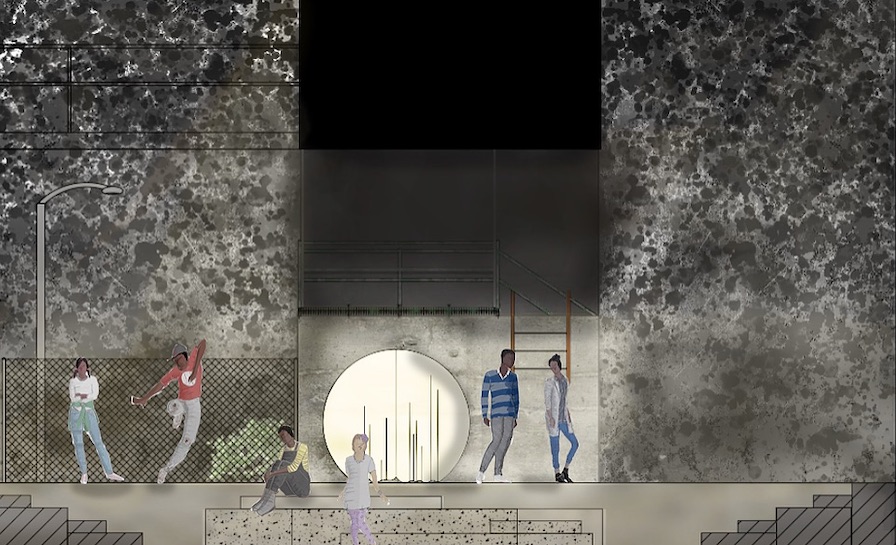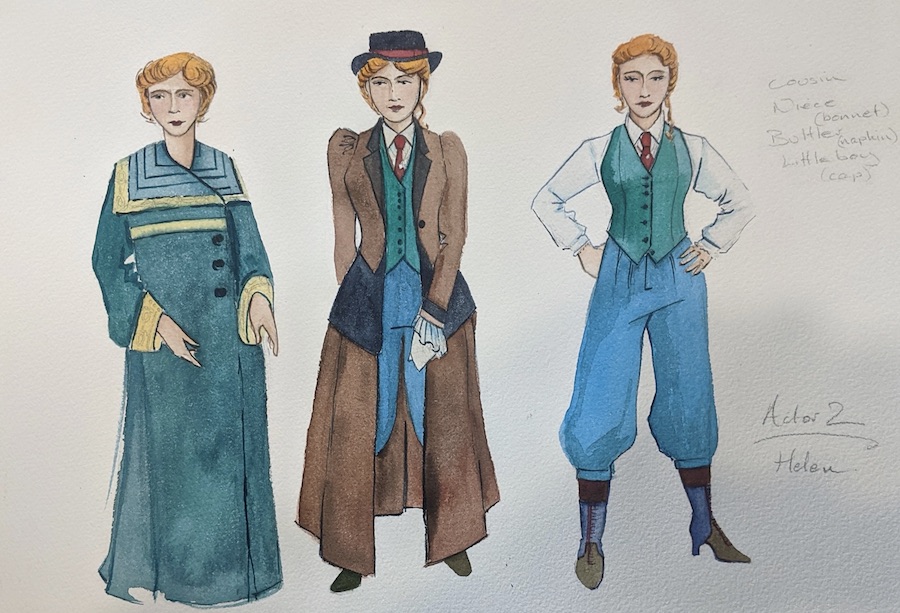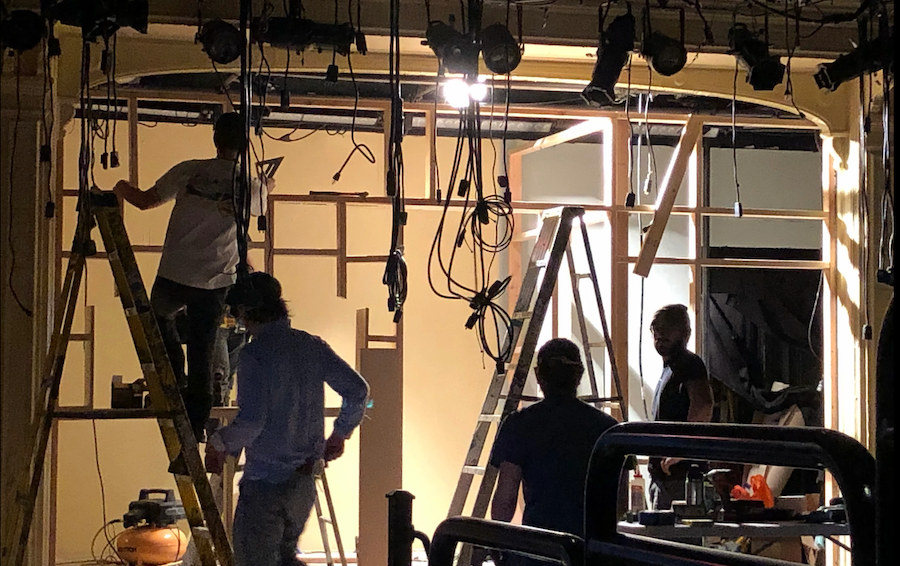As theatres shuttered in early spring, and theatre workers sprang to action creating and presenting works online, one facet of the theatre ecology was left out of the Zoom rooms: the designers. Indeed, some sets and costumes are still sitting in dark theatres gathering dust. For the creative teams, there was no strike or closure to mourn the postponed and canceled shows, and few opportunities to create and share new work online.
Enter HOLD: Design for Empty Rooms, a website that showcases halted productions with a soup-to-nuts peek at the design process. From audio files to costume renderings, from color palettes to pre-production photos, the website offers a glimpse at the directions some of the 2020 spring productions were headed.
“I started thinking about a way in which we could really celebrate the work of all these designers and creative teams that were at whatever point in their process at the point of shutdown,” says projection designer Kathrine Freer, who spearheaded the project.
An initial email chain linking designers from coast to coast brought together a team of 11 designers interested in creating a space online to recognize the suspended productions. The far-flung cohort stewarding the site includes Freer, Alex Koch, Arnulfo Maldonado, Deb Sivigny, Edward Morris, Jane Shaw, Melissa Ng, Thom Weaver, David Reynoso, Masha Tsimring, and Tara Webb.
“A big impetus for undertaking this was not to create something that was like a memorial, but something that was like intentional joy and celebration of these pieces that will no longer necessarily see an audience in the foreseeable future,” adds Freer.
Currently, the website features 10 paused productions: In the Blood at Purdue University in West Lafayette, Ind; Vietgone at Geva Theater Center in Rochester, N.Y.; Howards End at Portland Center Stage in Portland, Ore.; The Siblings Play at Rattlestick Playwrights Theatre in New York City; The Rocky Horror Show at A.C.T. San Francisco; A Doll’s House, Part 2 at Cleveland Playhouse in Ohio; The Karamazovs at New Ohio Theatre in New York City; Fidelio at San Francisco Opera; The Misanthrope at Lantern Theater Company in Philadelphia; and Esther Choi and the Fish that Drowned at Simpatico Theatre in Philadelphia.
“Because all of these different productions stopped in such different spots in their process timeline, we knew we could really use it as an opportunity to look at parts of the process that we don’t usually lift up,” says lighting designer Masha Tsimring, noting that design processes are nonlinear.
The page on Howards End, for which Tsimring served as lighting designer, features a scenic script breakdown and an unfinished lighting plot. The Karamazovs page includes research for lighting and photos of maquettes. A page for The Siblings Play, which began previews in March, documents the load-in process through photos.
For her part, sound designer Jane Shaw organized a group call for the creative team of A Doll’s House, Part 2, which will be posted on the website. Shaw had 12 productions canceled because of the pandemic, but this is the only one that had some semblance of closure. “The team got together and in a loving way put the baby to bed,” says Shaw, noting that the designers shared their plans for the show and talked through the potential challenges that would have surfaced in the production process.
The deep dive into the different processes is a great resource for design students. As schools transfer courses online, the HOLD: Design for Empty Rooms website will be a useful tool. The site lists a page of resources, including links to other virtual platforms, organizations, and theatre journals (including American Theatre.)
In addition to production photos of sets and costume sketches, the site includes the nitty-gritty of meeting notes, email chains, and communications between designers and directors. A page dedicated to Lantern Theater Company’s paused production of The Misanthrope even features an email correspondence between the costume designer Natalia de la Torre and a high school student communicating about a prospective internship.
“Speaking as an educator, I know that like this site is going to be really useful for teaching my students about process,” says scenic and costume designer Deb Sivigny, who teaches at George Mason University. “For people who want to do this in the future, this is actually what the job is—all guts, some glory,” she says with a laugh.
While educators and students gear up for another semester of remote learning, the HOLD: Design for Empty Rooms team is confident that design students can glean lessons from collaborating in a virtual classroom. Having this virtual space for design is more representative of how the myriad processes come together—through collaborative mood boards and email discussions.
“My students think of the design entities being very separate and I’m like, ‘No, you have to talk to each other.’ I rely on lighting and sound designers for the best script analysis and dramaturgical thinking,” says Sivigny.

In addition to paying homage to would-be productions, the website looks to the future. It is a space for designers to, well, design a way forward for the theatre community. Part of looking ahead is dismantling the hierarchy of the theatrical design process, which ostensibly places scenic design at the top. The order in which designers are invited to production meetings, and when, is part of a larger issue within the “theatre industrial complex,” explains Freer. But on HOLD: Design for Empty Rooms, all aspects of the creative process appear side by side.
“I became a scenic designer because I felt like I was missing out,” explains Sivigny, who also designs costumes. “Often I’d walk into processes and the set would be done, and I would be handed the color palette and told, ‘Work with this.’ I got into scenic and I’m like, oh, it’s lonely at the top. I don’t want to be in a process where I’m just the only one. and I’ve started speaking up about that—I need to meet with the rest of the team, I can’t do this without the crew.”
To that end, when a designer submits a production to be featured on the site, the HOLD team extends an invitation to the show’s entire creative team and crew to contribute materials.
Shaw says it is magical “watching those materials get rub up against each other in different ways” on the website. “I think there’s a lot of value to that, so I feel like we’re actually living that idea through the way the website is designed. The shows are richer when that hierarchy is broken down.”
The website is also disrupting the hierarchy of design by opening up the opportunity to submit shows to designers of all disciplines across the country. “We are putting the intentional time into expanding our circles and networks,” says Freer.
This outreach also includes students. “The students lost a lot of productions too,” says Tsimring. “And they did a lot of work. Every production is precious, but when you’re a student, you know, maybe it’s your first one that’s realized—when that gets cancelled, I think it can feel really lonely. It’s great to bring to hopefully bring them into the greater design community.”
Purdue University students are represented on the site with the school’s production of Suzan-Lori Parks’s In the Blood, slated for a Sept. 25 open, which is currently in flux. Its status is dubiously listed as “Postponed?”
Baxter Chambers, a third year MFA student, contributed this artistic statement to the site: “After finishing all the design meetings on campus, I left Indiana for what was supposed to be spring break without realizing I wouldn’t be returning for quite some time. These renderings were completed with my rudimentary knowledge of Photoshop rather than my usual pastels, which sat a few hundred miles away as I stayed cooped up in a third floor apartment in NW Ohio. This was during those first few weeks where there was still some hope that we would be back to something normal in short order.”
Moving forward, the team of designers will continue to curate and spotlight all the various tendrils of theatrical design, beyond this current period of pause.
“When we began the process it was much more about looking back—reflecting and celebrating,” says Freer, noting that the team postponed the launch to make space for the Black Lives Matter movement. “We still want to do that, but in the idea of, how do we look back to imagine our way forward? What do we want to take forward and what do we want to leave behind? As designers, our whole job is to invent realities and design worlds and spaces that we would like to inhabit. So this time is very ripe for creative teams and those kinds of conversations.”
Creative credits for photos: In the Blood by Suzan-Lori Parks at Purdue University, directed by Tasia Jones, with scenic design by Kate Cardinalli, costume design by Allison Jones, lighting design by Baxter Chambers, and sound design by Delaney Shay; Vietgone by at Geva Theater Center by Qui Nguyen, directed by Pirronne Yousefzadeh, with secnic design by Mikiko Suzuki MacAdams, costume design by Nicole Wee, lighting design by Seth Reise, sound design by Daniel Perelstein, and projection design by Katherine Freer; Howards End by Caroline Hewitt at Portland Center Stage, directed by Marissa Wolf, with set design by Kimie Nishikawa, costume design by Sarita Fellows, lighting design by Masha Tsimring, composition by Elisheba Ittoop, and sound design by Ben Scheff; The Siblings Play by Ren Dara Santiago at Rattlestick Playwrights Theatre, directed by Jenna Worsham, with scenic design by Angelica Borrero; costume design by Andy Jean, lighting design by Zach Blane, and sound design by Michael Costagliola; The Rocky Horror Show by Richard O’Brien at A.C.T. San Francisco, directed and choreographed by Sam Pinkleton, with scenic and costume design by David Reynoso, lighting design by Alexander Nichols, and sound design by Jessica Paz; A Doll’s House, Part 2 by Lucas Hnath at Cleveland Playhouse, directed by Alice Reagan, with set design by Collette Pollard, costume design by Lex Liang; lighting design by Stacey Derosier; and sound design by Jane Shaw; The Karamazovs written and directed by Anna Brenner at the New Ohio Theatre, with set and lighting design by Oona Curley, composition and sound design by Elizabeth Atkinson, costume design by Oana Botez, projection design by Yana Biryukova, props design by Buffy Cardoza; and video associate and graphic design byTatiana Stolpovskaya; Fidelio by Ludwig van Beethoven, Josef Sonnleithner, and Georg Friedrich Treitschke at San Francisco Opera, directed by Matthew Ozawa, with scenic and projection design by Alexander Nichols, costume design by Jessica Jahn, and lighting design by Jax Messenger; The Misanthrope adapted by Peter DeLaurier from Molière atLantern Theater Company, directed by Claire Moyer, with scenic design by Apollo Weaver, costume design by Natalia de la Torre, lighting design by Abby Schlackman, and composition and sound design by Elizabeth Atkinson; Esther Choi and the Fish that Drowned by Stephanie Kyung Sun Walters at Simpatico Theatre, directed by Cat Ramirez, with set design by Apollo Mark Weaver, costume design by Ariel Wang, lighting design by Abby Schlackman, and sound design by Anthony Martinez-Briggs.




